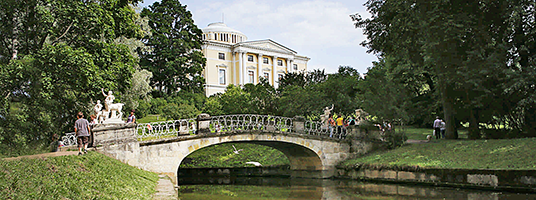Pavlovsk
The first settlement on the territory of modern Pavlovsk appeared in the XIII century. It was the Novgorod fortress "Town on Slavyanka", which refers to the Vodskaya pyatina of the Novgorod land. In the middle of the XVIII century there were two Ingrian villages Seppel and Lynn, near which were located forest lands for the royal hunt. In 1777 on the territory of these lands was based the Pavlovsk village, named in honor of the first owner - Emperor Paul I. November 12, 1796 after his accession to the throne, Paul I signed a decree to rename the village to the city of Pavlovsk. In 1918-1944 the city was named Slutsk on honor of the killed near Tsarskoye Selo a revolutionary Vera Slutskaya.
Prior to 1917 the border between the city and the palace and park of the city did not exist. Currently, along the southern and western boundary of the park is running the central city thoroughfares - Garden Street. The entire north side of Sadovaya Street takes the ensemble of the Grand Palace and Pavlovsk Park. There was a regular layout with breech and narrow-minded "civil" buildings on the other side of the street from the XVIII century.
The palace and park ensemble "Pavlovsk", which is a cultural monument the heyday of Russian classicism of the late XVIII - XIX centuries, dates back to the founding of the city in 1777. The core of the palace and park complex – the Pavlovsk Palace. The palace adjoins the park area of about 600 hectares, located on both banks of the river Slavyanka. The palace and park were built over half a century by several generations of architects and designers: Charles Cameron, Vincenzo Brenna, Giacomo Quarenghi, Andrei Voronikhin, Carlo Rossi.
The proposed collection includes several selections of visual materials about the history and the present day of the Pavlovsk Palace and Park.
- Museum-Reserve “Pavlovsk”. Revived beauty
The collection includes photographs from the State Museum-Reserve "Pavlovsk", reflecting the reconstruction of the palace and park ensemble in the postwar period.





